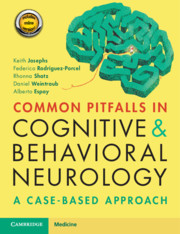Book contents
- Common Pitfalls in Cognitive and Behavioral Neurology
- Common Pitfalls in Cognitive and Behavioral Neurology
- Copyright page
- Dedication
- Contents
- Diseases Discussed in the Book
- Preface
- Acknowledgements
- Abbreviations
- Part 1 Missing the Diagnosis Altogether
- Part 2 Misidentifying the Impaired Cognitive Domain
- Part 3 Missing Important Clues in the History
- Part 4 Failure of Pattern Recognition
- Part 5 Difficult-to-Characterize Cognitive/Behavioral Disorders
- Part 6 Clinical Findings That Are Subtle
- Part 7 Misinterpreting Test Results
- Part 8 Attributing Findings to a Known or Suspected Disorder
- Part 9 Missing Radiographic Clues
- Part 10 Management Misadventures
- Case 46 I Don’t Know When to Stop
- Case 47 Is It Still Helping?
- Case 48 Caring for the Caregiver
- Case 49 Better Safe than Sorry?
- Case 50 Great Expectations
- Case 51 Nothing Can Be Done
- Index
- Plate Section (PDF Only)
- References
Case 46 - I Don’t Know When to Stop
from Part 10 - Management Misadventures
Published online by Cambridge University Press: 03 November 2020
- Common Pitfalls in Cognitive and Behavioral Neurology
- Common Pitfalls in Cognitive and Behavioral Neurology
- Copyright page
- Dedication
- Contents
- Diseases Discussed in the Book
- Preface
- Acknowledgements
- Abbreviations
- Part 1 Missing the Diagnosis Altogether
- Part 2 Misidentifying the Impaired Cognitive Domain
- Part 3 Missing Important Clues in the History
- Part 4 Failure of Pattern Recognition
- Part 5 Difficult-to-Characterize Cognitive/Behavioral Disorders
- Part 6 Clinical Findings That Are Subtle
- Part 7 Misinterpreting Test Results
- Part 8 Attributing Findings to a Known or Suspected Disorder
- Part 9 Missing Radiographic Clues
- Part 10 Management Misadventures
- Case 46 I Don’t Know When to Stop
- Case 47 Is It Still Helping?
- Case 48 Caring for the Caregiver
- Case 49 Better Safe than Sorry?
- Case 50 Great Expectations
- Case 51 Nothing Can Be Done
- Index
- Plate Section (PDF Only)
- References
Summary
This 59-year-old right-handed man exhibited unusual behavioral changes. He had been diagnosed with Parkinson disease (PD) four years ago. Since then, he was benefiting motorically from pramipexole, gradually increased to 1 mg three times a day. While he felt there were no problems, his wife reported that over the past year he became more withdrawn. She reported that he no longer played tennis on Saturdays, a lifelong tradition, nor did he ride his motorcycle, which he always loved doing. Previously a very social person, he did not participate in social activities and preferred to stay at home. He was spending most of his time playing games on the computer, most of them for money, something he had never done before. His wife noticed he was now sleeping less as he played until late hours. They could not tell how much money had been spent in these games. He continued to work, but his supervisor noticed a decline in his performance which he attributed to spending a significant amount of time playing on the computer.
- Type
- Chapter
- Information
- Common Pitfalls in Cognitive and Behavioral NeurologyA Case-Based Approach, pp. 149 - 152Publisher: Cambridge University PressPrint publication year: 2020



